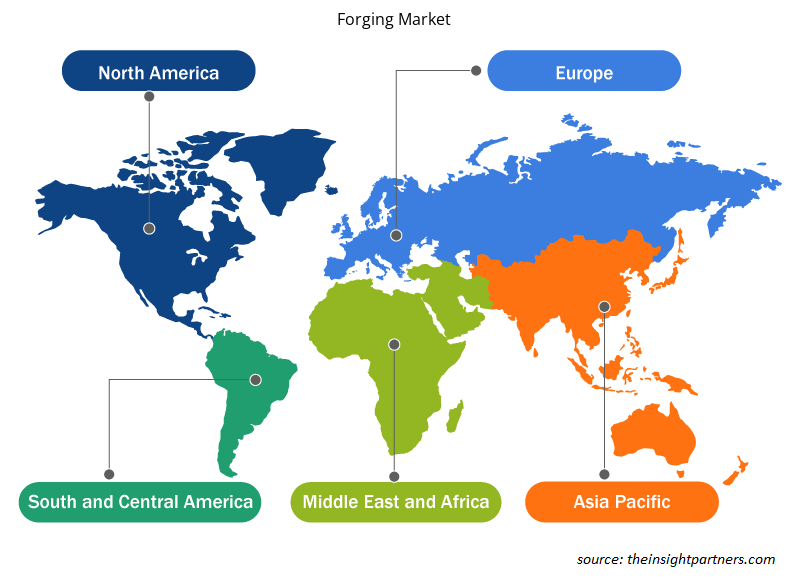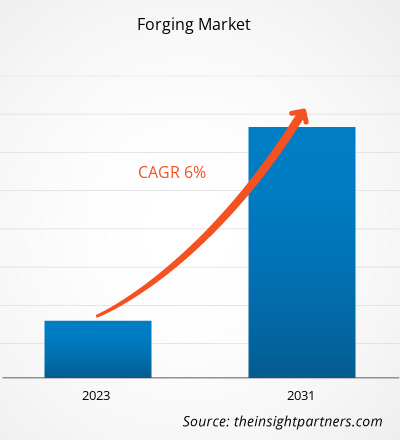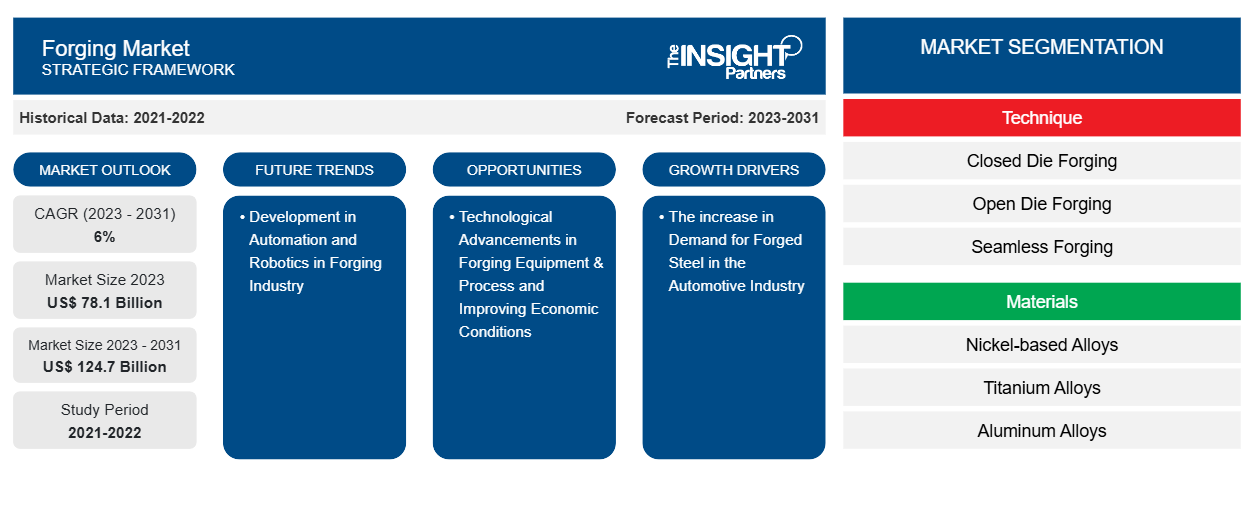Se proyecta que el tamaño del mercado de la forja alcance los 124.700 millones de dólares en 2031, frente a los 78.100 millones de dólares en 2023. Se espera que el mercado registre una CAGR del 6 % durante el período 2023-2031. Un aumento de la inversión en generación de energía renovable y una mayor demanda de las industrias aeroespacial, automotriz y de la construcción son algunos de los factores que impulsan el mercado de la forja.
Análisis del mercado de la forja
El mercado mundial de la forja está creciendo modestamente debido a la creciente demanda de las industrias automotriz y aeroespacial. El aumento del tráfico aéreo de pasajeros ha dado lugar a la expansión del sector aeroespacial, impulsando la fabricación de piezas aeroespaciales forjadas. Además, varios gobiernos de todo el mundo están invirtiendo cada vez más en proyectos de energía eólica, lo que está aumentando la demanda de componentes forjados para energía eólica. Sin embargo, la disponibilidad de sustitutos baratos y los altos costos están restringiendo la expansión del mercado de la forja hasta cierto punto.
Descripción general del mercado de la forja
Con el aumento de la población y la industrialización, la demanda de energía está aumentando a nivel mundial. El aumento del consumo de energía ha impulsado la necesidad de inversión en plantas de generación de energía y desarrollo de infraestructura, impulsando aún más la demanda de componentes forjados, como accesorios, bridas, válvulas, pernos, recipientes y tuercas. La industria de la forja ha alcanzado un lugar importante en la economía industrial global al producir componentes con ventajas únicas que son difíciles de duplicar. La resistencia, confiabilidad y durabilidad de los componentes forjados los han convertido en la opción preferida en una variedad de aplicaciones industriales donde la resistencia a la fatiga y la tenacidad a la fractura son fundamentales para la seguridad de las personas y los equipos.
Personalice este informe según sus necesidades
Obtendrá personalización en cualquier informe, sin cargo, incluidas partes de este informe o análisis a nivel de país, paquete de datos de Excel, así como también grandes ofertas y descuentos para empresas emergentes y universidades.
- Obtenga las principales tendencias clave del mercado de este informe.Esta muestra GRATUITA incluirá análisis de datos, desde tendencias del mercado hasta estimaciones y pronósticos.
Creando impulsores y oportunidades de mercado
Demanda creciente de acero forjado en la industria automotriz
La durabilidad, confiabilidad y resistencia de las piezas forjadas de acero las convierten en una opción preferida en la industria automotriz. El acero inoxidable, las aleaciones y el acero al carbono se encuentran entre los tipos de acero más utilizados en la industria automotriz para producir diversos componentes, como bielas, brazos de control, balancines, cigüeñales, árboles de levas, extremos de las barras de dirección y muñones de dirección. El proceso de forjado de acero puede producir piezas automotrices con formas casi netas, sin necesidad de mecanizado adicional a través del método de matriz cerrada, lo que ahorra dinero y tiempo. Además, el método de forjado de matriz cerrada se puede utilizar para personalizar todo tipo de componentes automotrices hechos de aleaciones de acero, como el acero ASTM4140 y el acero AISI 1045. Las técnicas de forjado de acero en matriz cerrada se utilizan principalmente para fabricar piezas automotrices para varios vehículos comerciales y de pasajeros y piezas forjadas de acero liviano para vehículos eléctricos (VE). Por lo tanto, el uso creciente de acero forjado en la industria automotriz está impulsando el mercado de la forja.AISI 1045 steel. The closed die steel forging techniques are mostly used for manufacturing automotive parts for various commercial and passenger vehicles and lightweight steel forgings for electric vehicles (EVs). Thus, the growing use of forged steel in the automotive industry is driving the forging market.
Mejora de las condiciones económicas y avances tecnológicos en equipos y procesos de forja
En las industrias de rápido desarrollo, la demanda de productos forjados complejos e innovadores está aumentando. El proceso automatizado de forjado en matriz cerrada ha atraído la atención de los proveedores de equipos hacia el desarrollo de nuevos equipos y procesos de forjado. En aplicaciones aeroespaciales comerciales, estas nuevas máquinas de forjado pueden forjar piezas de aleación de níquel y titanio de gran tamaño. Actualmente, la automatización en la industria tiene un impacto positivo moderado en el crecimiento del mercado de forjado en matriz cerrada, pero se espera que aumente durante el período de pronóstico.
Las empresas que operan en este mercado se dedican a proporcionar procesos de forjado flexibles, resistentes, adaptables y eficientes para hacer frente a la creciente competencia en el mercado de conformado de metales. Además, las industrias de uso final como el petróleo y el gas, la construcción naval, la automoción, la generación de energía, la industria aeroespacial y la construcción están experimentando un crecimiento significativo en países como la India y China en lo que respecta a los productos forjados en matriz cerrada. Por lo tanto, se espera que la mejora de las condiciones económicas y las constantes innovaciones tecnológicas en las técnicas de forjado brinden oportunidades en el mercado de la forja durante el período de pronóstico.
Análisis de segmentación del informe del mercado de forja
Los segmentos clave que contribuyeron a la derivación del análisis del mercado de forja son la técnica, el material y la industria.
- Según la técnica, el mercado de la forja se ha dividido en forja en matriz cerrada, forja en matriz abierta y forja sin costura. El segmento de forja en matriz cerrada tuvo la mayor participación de mercado en 2023.
- Según el material, el mercado de la forja se ha dividido en aleaciones a base de níquel, aleaciones de titanio, aleaciones de aluminio, aleaciones de acero y otras. El segmento de aleaciones de acero tuvo la mayor participación de mercado en 2023.
- Por industria, el mercado está segmentado en automoción , aeroespacial, ferroviario, maquinaria pesada y energía eólica. El segmento automotor dominó el mercado en 2023.
Análisis de la cuota de mercado de la forja por geografía
El alcance geográfico del informe del mercado de forja se clasifica principalmente en cinco regiones: América del Norte, Europa, Asia Pacífico, Medio Oriente y África, y América del Sur y Central.
En 2023, el mercado de la forja en Asia Pacífico dominó el mercado de la forja. El mercado de la forja en Asia Pacífico está segmentado en Australia, China, Japón, India, Corea del Sur y el resto de Asia Pacífico. Se prevé que la creciente demanda de componentes forjados de metal para aplicaciones como el ferrocarril, la construcción, la generación de energía, la industria aeroespacial y la automoción impulse el crecimiento del mercado de la forja durante el período de pronóstico. China es el principal consumidor y fabricante de piezas forjadas de metal en Asia Pacífico. China está exportando una gran cantidad de productos forjados a países estadounidenses y europeos. La presencia de varias asociaciones en China que trabajan por el crecimiento del proceso de forja es uno de los principales factores que contribuyen al crecimiento del mercado de la forja. Además, debido a la presión del mercado y del gobierno, la industria de la forja de China se esfuerza por producir piezas forjadas con mayor precisión, mayor eficiencia, digitalización más generalizada, menor peso y menor consumo de energía. Recientemente se han observado muchos logros excelentes en I+D y fabricación de maquinaria de forja, aplicación de simulación, aplicación de TI y, especialmente, forja de precisión.
Perspectivas regionales sobre el mercado de forja
Los analistas de Insight Partners explicaron en detalle las tendencias y los factores regionales que influyen en el mercado de la forja durante el período de pronóstico. Esta sección también analiza los segmentos y la geografía del mercado de la forja en América del Norte, Europa, Asia Pacífico, Oriente Medio y África, y América del Sur y Central.

- Obtenga los datos regionales específicos para el mercado de forja
Alcance del informe sobre el mercado de la forja
| Atributo del informe | Detalles |
|---|---|
| Tamaño del mercado en 2023 | US$ 78,1 mil millones |
| Tamaño del mercado en 2031 | US$ 124,7 mil millones |
| CAGR global (2023 - 2031) | 6% |
| Datos históricos | 2021-2022 |
| Período de pronóstico | 2023-2031 |
| Segmentos cubiertos | Por técnica
|
| Regiones y países cubiertos | América del norte
|
| Líderes del mercado y perfiles de empresas clave |
|
La densidad de actores del mercado de forja: comprensión de su impacto en la dinámica empresarial
El mercado de la forja está creciendo rápidamente, impulsado por la creciente demanda de los usuarios finales debido a factores como la evolución de las preferencias de los consumidores, los avances tecnológicos y una mayor conciencia de los beneficios del producto. A medida que aumenta la demanda, las empresas amplían sus ofertas, innovan para satisfacer las necesidades de los consumidores y aprovechan las tendencias emergentes, lo que impulsa aún más el crecimiento del mercado.
La densidad de actores del mercado se refiere a la distribución de las empresas o firmas que operan dentro de un mercado o industria en particular. Indica cuántos competidores (actores del mercado) están presentes en un espacio de mercado determinado en relación con su tamaño o valor total de mercado.
Las principales empresas que operan en el mercado de forja son:
- Corporación Alcoa
- Grupo All Metals & Forge
- Maquinaria CFS Co., Ltd.
- Ficep SpA
- Forja Bharat limitada
- Tecnologías Allegheny Incorporated
Descargo de responsabilidad : Las empresas enumeradas anteriormente no están clasificadas en ningún orden particular.

- Obtenga una descripción general de los principales actores clave del mercado de forja
Noticias y desarrollos recientes del mercado de forja
El mercado de la forja se evalúa mediante la recopilación de datos cualitativos y cuantitativos a partir de una investigación primaria y secundaria, que incluye publicaciones corporativas importantes, datos de asociaciones y bases de datos. A continuación se enumeran algunos de los avances en el mercado de la forja:
- En abril de 2024, Ramkrishna Forgings firmó un acuerdo de suministro con el mayor fabricante de vehículos eléctricos de pasajeros de EE. UU. A través de este acuerdo, la empresa suministrará componentes del sistema de propulsión y debutará como proveedor en el mercado de vehículos eléctricos de EE. UU.
- En febrero de 2024, US Forged Rings anunció una inversión de 700 millones de dólares en la industria eólica marina para la construcción de una planta de fabricación de torres y una planta de forjado de acero. Con este desarrollo, la empresa fortalecerá su posición en el mercado.
Informe sobre el mercado de la forja: cobertura y resultados
El informe “Tamaño y pronóstico del mercado de forja (2021-2031)” proporciona un análisis detallado del mercado que cubre las siguientes áreas:
- Forjar el tamaño del mercado y preverlo a nivel mundial, regional y nacional para todos los segmentos clave del mercado cubiertos por el alcance
- Forjar tendencias del mercado, así como dinámicas del mercado, como impulsores, restricciones y oportunidades clave.
- Análisis detallado de las cinco fuerzas de Porter y PEST y FODA
- Análisis del mercado de forja que cubre las tendencias clave del mercado, el marco global y regional, los principales actores, las regulaciones y los desarrollos recientes del mercado.
- Análisis del panorama de la industria y de la competencia que abarca la concentración del mercado, el análisis de mapas de calor, los actores destacados y los desarrollos recientes del mercado de la forja
- Perfiles detallados de empresas
- Análisis histórico (2 años), año base, pronóstico (7 años) con CAGR
- Análisis PEST y FODA
- Tamaño del mercado, valor/volumen: global, regional y nacional
- Industria y panorama competitivo
- Conjunto de datos de Excel
Informes recientes
Testimonios
Razón para comprar
- Toma de decisiones informada
- Comprensión de la dinámica del mercado
- Análisis competitivo
- Información sobre clientes
- Pronósticos del mercado
- Mitigación de riesgos
- Planificación estratégica
- Justificación de la inversión
- Identificación de mercados emergentes
- Mejora de las estrategias de marketing
- Impulso de la eficiencia operativa
- Alineación con las tendencias regulatorias





















 Obtenga una muestra gratuita para - Mercado de la forja
Obtenga una muestra gratuita para - Mercado de la forja